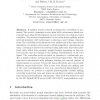451 search results - page 48 / 91 » Learning conditional preference networks |
NECO
1998
13 years 8 months ago
1998
Synaptic runaway denotes the formationof erroneous synapses and premature functional decline accompanying activity-dependent learning in neural networks. This work studies synapti...
IWANN
2005
Springer
14 years 2 months ago
2005
Springer
Abstract. A spiking neural network modeling the cerebellum is presented. The model, consisting of more than 2000 conductance-based neurons and more than 50 000 synapses, runs in re...
CORR
2008
Springer
13 years 8 months ago
2008
Springer
The solving of least square systems is a useful operation in neurocomputational modeling of learning, pattern matching, and pattern recognition. In these last two cases, the soluti...
AVSS
2009
IEEE
14 years 3 days ago
2009
IEEE
—Automatic understanding of human behavior is an important and challenging objective in several surveillance applications. One of the main problems of this task consists in accur...
CEC
2010
IEEE
13 years 10 months ago
2010
IEEE
For any embodied, mobile, autonomous agent it is essential to control its actuators appropriately for the faced task. This holds for natural organisms as well as for robots. If sev...

